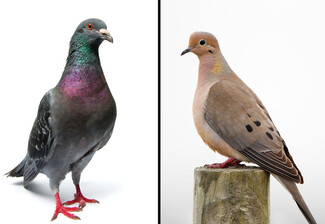Pigeons and Doves: Coexisting with Wildlife
Last updated 9/14/2023 at 11:28am
There are five species of doves and two species of pigeons in San Diego County. Project Wildlife helps about 1,100 pigeons and doves every year. Most calls to Project Wildlife will be about Mourning Doves and Rock Doves (pigeons). Common pigeons (Rock Doves) are not protected by the Migratory Bird Act and can be kept as pets or poisoned as pests. The Band Tailed Pigeon is native, is protected and of special interest to wildlife officials in California.
The most common types of baby pigeon and dove calls Project Wildlife receives, is about a fledgling found on the ground and that something seems wrong. Fledglings will spend most or all of there time on the ground learning to fly while being fed by the parents. It is important to be sure that the parents are not coming back to the animal before it is brought to Project Wildlife.
If a nestling is found on the ground: Put it back in the nest. If the bird jumps out of the nest, it has probably fledged and will remain on or near the ground. If the nest is difficult to get to, a temporary nest can be fashioned out of a berry basket or similar item, lined with tissue and attached to the tree. Always watch for the parents for an hour to ensure they return to the nestling. Fledglings will spend most or all of their time on the ground learning to fly while fed by their parents. It's important to be sure that the parent birds aren't coming back before intervening.
We sometimes get calls about friendly pigeons with bands on their legs. If you find a friendly pigeon with bands on its legs: These are someone's pet. Information to help locate the owner can be found here.
If it is determined that the bird needs rescue, place it in a box lined with tissue and with a lid with holes. Limit handling the bird as they are very easily stressed. Always keep it out of site of children and pets. If it is cool/cold, it can be kept warm with a heat lamp or heating pad. Keep the bird warm, dark and quiet.
When does a baby pigeon or dove need to come to the Project Wildlife Care Center?
It is injured or bleeding.
It has been caught by a cat or other predator. It should always come to the care center because of the possibility of infection.
Its parents are known to be dead or don't return to the nest within an hour.
It's on the ground and a parent has not come around within an hour.
It's been brought from places unknown.
When does an adult pigeon or dove need to come to the Project Wildlife Care Center?
It is injured or bleeding.
It is caught by a cat or other predator.
Its wing is tweaked or drooping.
Shivering or falling to one side.
Open mouth breathing.
If you've found an injured animal and need information on where to take it, please call: (619) 299-7012 Please press option #4.
Instructions on how to transport a pigeon or dove:
If it is determined that the bird needs rescue, place it in a box lined with tissue and with a lid with holes.
Limit handling the bird as they are very easily stressed.
Always keep it out of site of children and pets.
If it is cool/cold, it can be kept warm with a heat lamp or heating pad.
Warm, dark and quiet are the essential three words to focus on
Courtesy of Project Wildlife's Educational outreach program




